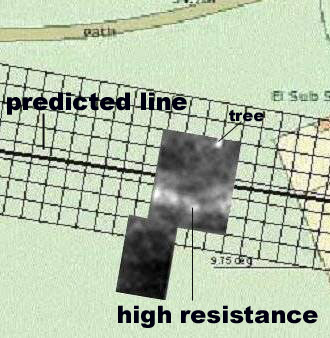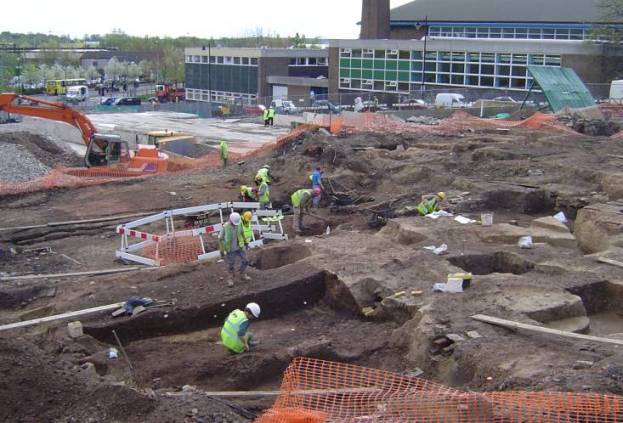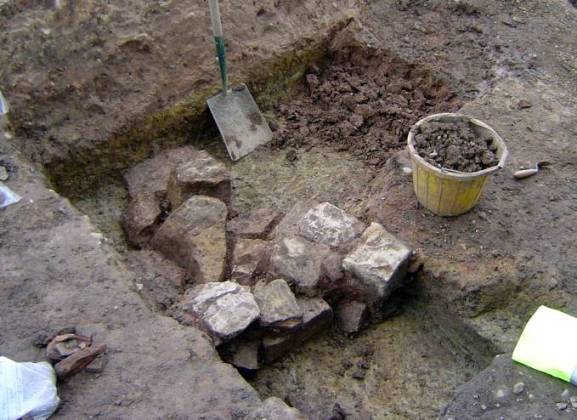 | Last month, a team of
society members ventured into Eccles to carry out a resistivity survey on the suspected
Roman Road from Manchester to Wigan. It was done at the invitation of John Rabbitt,
treasurer of the local resident’s association, who has been investigating the
possibility that a section of the Road crossed their estate. John is hoping to carry out
an excavation in late June as part of the Time Team’s Big Dig. When we got there John
had already marked out a patch of spare land called The Three Sisters where an early map
indicates its possible position. In fact, an excavation in the 1970’s had reported
discovering a stony surface here but the exact location had been lost. As you can see, the
results from our survey are quite convincing, with a positive bright patch in the centre
indicating the high resistance of the Road. John has also been negotiating with local
schools and has now gained permission for us to do another survey on their playing fields
so that we can establish the Road’s direction. We will arrange a date for this next
visit at the next meeting. |
Extension Granted
 Shepherds, who are the developers of Wigan’s Grand Arcade project, have
given the archaeologists an extra five weeks to finish off the excavations in Millgate.
This is great news as the quantity and quality of the finds from the site are exceeding
all expectations. The latest find is a huge colonnaded building dating from the early 2nd
century AD. The walls, in places, are almost one metre thick and made of high quality
masonry (suggesting military construction). Most of the stone has been ‘robbed
out’ but occasionally some of it still survives. Offset from the corner of the
building, a huge square stone plinth (and signs of others) confirms that an impressive
colonnade surrounded this building. This is quite remarkable, as you need to go as far
away as Chester or York to find a building of comparable stature. Its function is still a
mystery but the lack of occupation debris suggests a public building e.g. Mansio, basilica or even temple. The hypocaust building
mentioned in last month’s newsletter, was similarly constructed but is clearly from a
later phase. Most of the stone walling has again been taken, but the tile-built columns or
pilae have been left place. Shepherds, who are the developers of Wigan’s Grand Arcade project, have
given the archaeologists an extra five weeks to finish off the excavations in Millgate.
This is great news as the quantity and quality of the finds from the site are exceeding
all expectations. The latest find is a huge colonnaded building dating from the early 2nd
century AD. The walls, in places, are almost one metre thick and made of high quality
masonry (suggesting military construction). Most of the stone has been ‘robbed
out’ but occasionally some of it still survives. Offset from the corner of the
building, a huge square stone plinth (and signs of others) confirms that an impressive
colonnade surrounded this building. This is quite remarkable, as you need to go as far
away as Chester or York to find a building of comparable stature. Its function is still a
mystery but the lack of occupation debris suggests a public building e.g. Mansio, basilica or even temple. The hypocaust building
mentioned in last month’s newsletter, was similarly constructed but is clearly from a
later phase. Most of the stone walling has again been taken, but the tile-built columns or
pilae have been left place.  Again the function of this building is not certain; a
bathhouse is possible but, as evidence of a stoke-hole has yet to be found, it may have
been used for just grain storage (although the high quality of the masonry walls suggest
otherwise). At a later stage a large oven was built into the side of this building with
the burnt refuse being spread outside. Mark Bagwell, the excavation supervisor, says there
is evidence emerging of even more buildings situated close by, making the whole site a
quite extensive complex. Mark is confident, however, that he will be able to complete the
excavations in the time available. Ian Miller, the site director, is organising a public
viewing of the site on Saturday 14th May and a special preview for our society on the
evening of Wednesday 11th May. If you are interested please see me at the next meeting. Again the function of this building is not certain; a
bathhouse is possible but, as evidence of a stoke-hole has yet to be found, it may have
been used for just grain storage (although the high quality of the masonry walls suggest
otherwise). At a later stage a large oven was built into the side of this building with
the burnt refuse being spread outside. Mark Bagwell, the excavation supervisor, says there
is evidence emerging of even more buildings situated close by, making the whole site a
quite extensive complex. Mark is confident, however, that he will be able to complete the
excavations in the time available. Ian Miller, the site director, is organising a public
viewing of the site on Saturday 14th May and a special preview for our society on the
evening of Wednesday 11th May. If you are interested please see me at the next meeting.
From Romans to Roundheads
This year’s CBA NW Spring Conference is to be held at Heronbridge 2km south of
Chester on Saturday 14th May. It promises to be a good one with a range of talks covering
the full story of Heronbridge’s historical heritage. It includes the identification
of a War-grave associated with the Battle of Chester, fought in AD 616. Of particular
interest will be the Paleo-pathological evidence for battle casualties. The cost for the
whole day is £5 for CBA members £7 for non-members plus £5 for lunch.
Next Meeting
Wednesday 4th May at the Baden Powell Centre (Scout HQ) in Greenough Street, starting
at 7.30 pm as usual. This month the speaker is Derek Pearce, from South
Trafford Archaeological Group, who will be telling us about all their latest
activities.
Hope to see you there. B.A.
|



